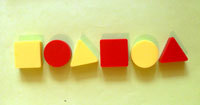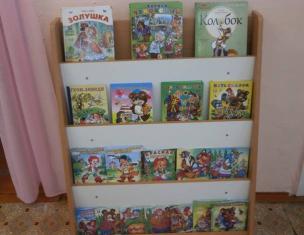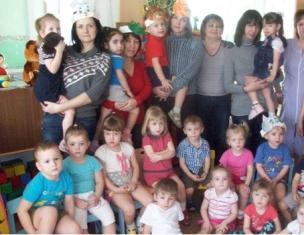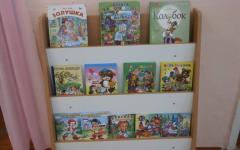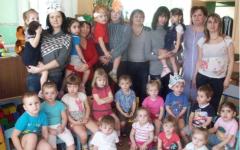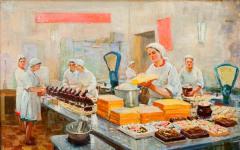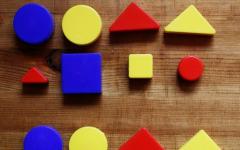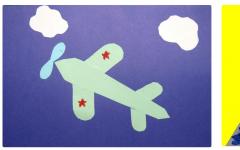Didactic game "How much?"
Material:
Logic figures.
Purpose of the game:
Develop the ability to ask questions and develop the ability to allocate properties.
Game description:
Children are divided into two teams. The educator folds logical figures in any order and invites children to come up with questions beginning with the words "how much ..."
For each right question, the chip. Wins a team that scores more chips.
Options: "How many big figures?" "How many red figures in the first row?" (Horizontal), "how many circles?" etc.
Didactic game " ARTISTS "
Material:
"Sketches of Paintings" - Sheets of Big Colored Cardboard
Additional parts from cardboard to compile the composition of the picture;
Set of blocks
Purpose of the game:
Development of ability to analyze the form of objects
Development of ability to compare by their properties
Development of art abilities (choice of color, background, location (composition).
Game description:
Children are invited to "write pictures" by sketches. One picture can "write" immediately
several people. Children choose a "sketch" of paintings, paper for the background, details to the future picture, the necessary blocks. If on the sketch, the part is only circled (contour items) - the thin unit is selected if the part is painted - a thick block. For example, the child will take additional details to the sketch of the patterns with elephants: 2 elephant heads, sunshine, lake, palm trees, cactus, animal and blocks.
At the end of the work, artists come up with their name to their paintings, arrange the exhibition
pictures, and the guide tells the visitors of the exhibition, which is shown in the picture.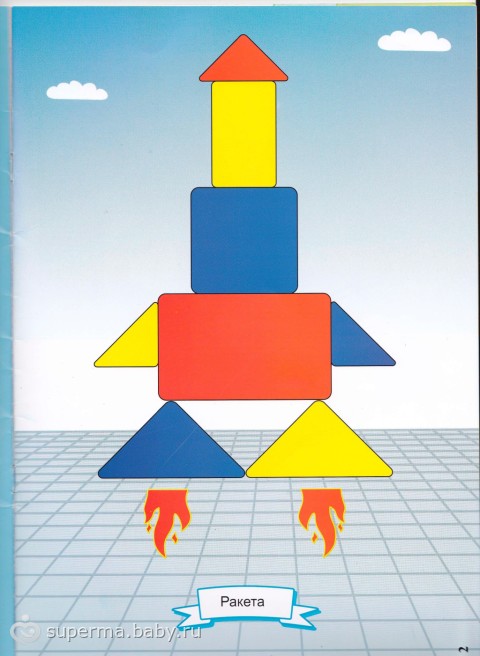
Didactic game "Store"
Material:
Product (Cards with the image of items) Logic figures.
Purpose of the game:
Development of the ability to identify and abstruct properties
Development of ability to reason, argue your choice
Game description:
Children come to the store, which contains a large selection of toys. Each child has 3 "money" logical figures. On one "money" you can buy only one toy.
Purchase Rules: You can only buy such a toy in which there is at least one property of a logical figure. The rule can be complicated to the choice of toys in two properties (for example, a large square, blue square, etc.)

Didactic game "What changed"
Tasks: 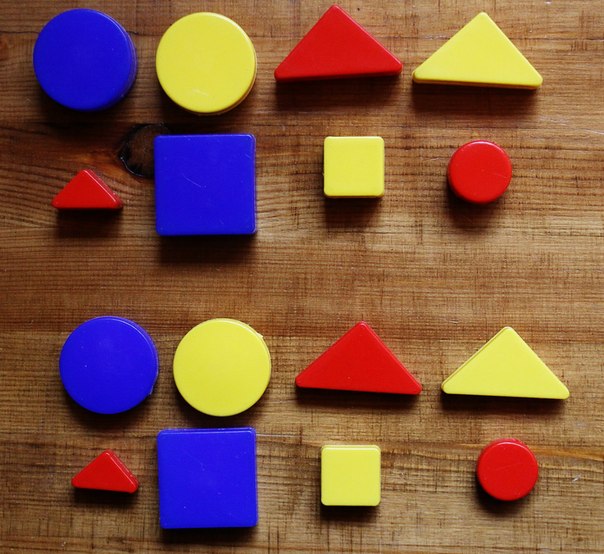
Improve the knowledge of children about geometric figures, their color, magnitude, thickness
Develop thinking.
Material: Set of dienesh blocks.
Game Travel: A few figures that need to be remembered to the table, and then one of the figures disappears or replaced with a new one, or two figures change places. The child should notice the changes.
Didactic game "Horovod"
Purpose: Classifies blocks on two - three features: color, form; Color - shape - size.
Material: dienesh logical blocks.
The course of the game.
The educator suggests to build magic figures in a cheerful dance. The dance will be beautiful and elegant.
Blocks are laid out in a circle. Any block arbitrarily comes, then the unit is attached, in which one sign of the previous block will be present and so on. The last block must match the first block one by any sign. In this case, the game ends - "dance" is closed.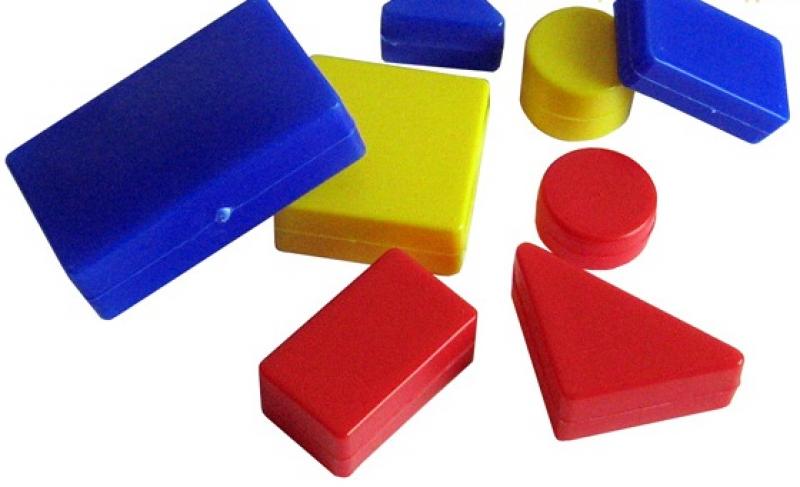
Didactic game "The second row"
Tasks:
Develop the ability to analyze, allocate the properties of the figures, find a figure, excellent one sign.
Material: Dienesh logical blocks.
Game traffic:
Share in a row 5-6 of any shapes. Build under them the second row, but so that under each figure of the upper row it turned out to be the figure of another form (color, size); the same form, but another color (size); Other color and size; Not so in shape, size, color.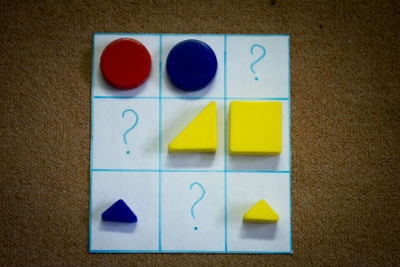
Didactic game "Find Clay"
Tasks : Improve children's knowledge of geometric shapes, their color, magnitude, thickness. Develop thinking.
Material: Set of dienesh blocks.
I put 8 logical blocks of Dieens in front of the child, and until he sees, under one of them hide the "treasure" (coin, pebbles, cut-out picture, etc.). The child must ask you leading questions, and you can only answer "yes" or "no": "Cold under the blue block?" - "No", "under the red?" - "Not". The child concludes that the treasure under the yellow block, and asks further about the size, shape and thickness. Then the "treasure" hides the child, and the educator sets the leading questions.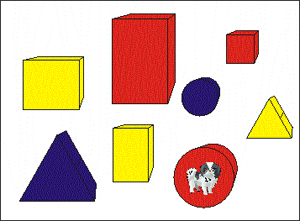
Then children who competing in finding treasure can play this game.
Didactic game "Game with one hoop"
Tasks:
Develop the ability to break the set of one property into two subsets to produce a logical operation "not".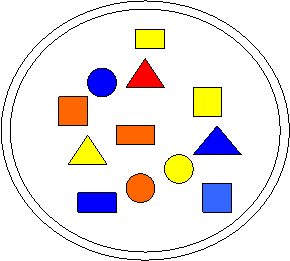
Material: Hoop, a set of logical blocks of Dieens.
Game traffic: Before starting the game, find out which part of the game sheet is located inside the hoop and outside it, establish the rules: for example, to have figures so that all red figures (and only they) are out of the hoop. After the location of all the figures, two questions are offered: what figures lie inside the hoop? What figures were out of the hoop? (An answer is supposed: "Out of the hoop, everything is not red figures"). When repeating the game, children can choose which blocks to put inside the hoop, and which out.
Didactic game "Play with two hoops"
Tasks: Development of the ability to break the set on two compatible properties, produce logical operations "not", "and", "or".
Material: 2 hoops, a set of logical blocks of Dieens.
Game traffic:
Before starting the game, it is necessary to find out where there are four areas defined on the game sheet with two hoops, namely: inside both hoops; inside red, but outside the green hoop; Inside the green, but outside the red hoop and out of both hoops (these areas need to be broken by a pointer).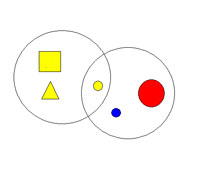
1. Came called the rule of the game. For example, lay the figures so that all the red figures are inside the red hoop, and everything is round inside the green.
2. The decision of the practical task of the location of the figures is responsible for questions: what kind of figures lie inside both hoars; inside green, but outside the red hoop; The game with two hoops is advisable to spend many times, varying the rules of the game.
Note: In options 5 and 6, the total part remains empty. It is necessary to find out why there are no shapes at the same time red and green, and there are no shapes at the same time round and square.
Didactic game "settles in houses"
Tasks: Develop the ability to analyze, allocate the properties of the figures, classify.
Material: Set of logical blocks of Dieens, tables with the image of tracks and houses
Game traffic:
Before children Table No. 1. The child needs to help each figure get into his house, focusing on signs signs.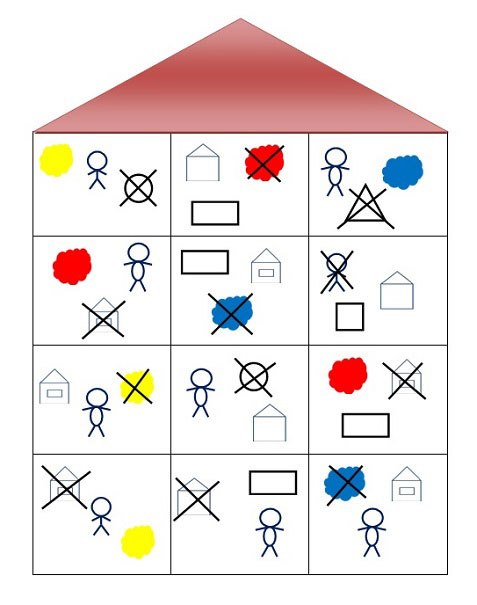
Didactic game "On his twig"
Tasks: Develop the ability to analyze, allocate the properties of the figures, classify the figures in several features.
Material: A set of 24 figures (four forms, three colors, two quantities). Each figure is a carrier of three important properties: shapes, colors, values, and according to this, the name of the figure consists of the name of the three properties: red, large rectangle; yellow, small circle; Green, large square, etc.
Game traffic:
The figure shows a tree on which the figures should "grow". To find out what branch what "will grow" the figure, take, for example, a green, small rectangle and start moving it from a tree root up branches. Following the color pointer, we must move the figure on the right branch. Reached branching. What branch move on? According to the right, which depicts a rectangle. They reached the next branching. Further, the Christmas tree shows that a large figure should be moved along the left branch, and on the right - small. So we will go on the right twig. Here and should "grow" a small green rectangle. We do the same with the rest of the figures. Similarly, play with the following pattern.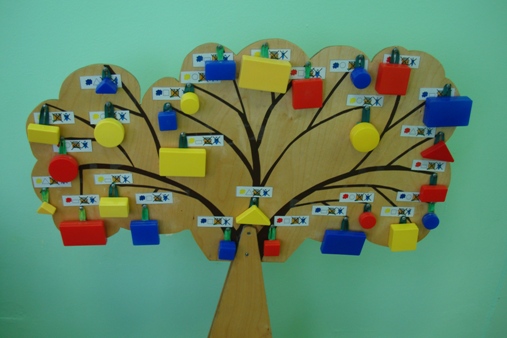
Didactic game "Chain"
Purpose:
Development of the ability to analyze, allocate the properties of figures, find a figure for a specified sign.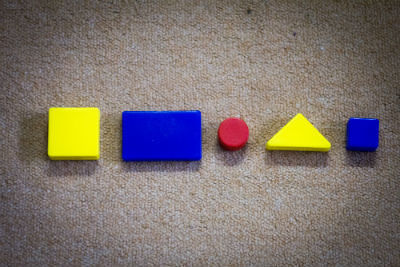
Material: A set of logical blocks of the Diena.
From an arbitrary chosen figure, try to build as a long chain as possible. Chain construction options:
So that there are no shape figures (color, size, thickness);
So that there are no equal in the form and color of figures (in color and size, in size and thickness, etc.);
So close the figures are the same in size, but different in shape, etc.;
So close the shapes of the same color and size, but of different shapes (the same size, but of different colors).
Didactic game "Help the fabulous hero"
Tasks:
Exercise children in grouping geometric shapes
Develop observation, attention and memory
The task:
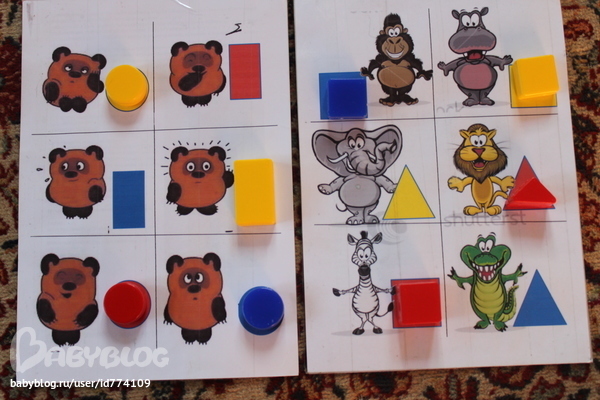
- Divide the figures between fabulous heroes so that:
Buratino had all blue squares
So that the pencil got all yellow
To keep the whole yellow and big
Didactic game "Floors"
Software tasks : Develop the ability to classify and summarize geometric shapes on features. Exercise in the account. Develop orientation in space, attention, logical thinking.
Material : Set of blocks.
Game traffic:
We offer to lay out a few figures in a row - 4-5 pcs. These are residents of the first floor. Now we build the second floor of the house so that the detail of another color (or size, form) is under each figure of the previous row.
Option 2: Detail of the same form, but other size (or colors).
Option 3: Build a house with other details in color and size.
The game is a fairy tale "In the kingdom of blocks"
Material: Dielesh blocks on one box for three people.
Purpose: To acquaint with blocks, their properties, develop attention, the ability to identify, abstract properties (size, shape, thickness), imagination, creative thinking.
Game description: Children choose color for their kingdom (yellow, blue, red). The presenter tells the fairy tale, and children prescribe blocks on the role of heroes, and build their kingdom of them.
"In some kingdom, there was a king in some state. He was strong, big, thick and looked like a rectangle (children choose a block - a large thick rectangle). The king had a queen, very similar to him, only thinner (choose a block - a large thin rectangle). They lived very happy, and they had two children, similar to them, only small (small thick and thin rectangles). And once ... "
Options: Next, the fairy tale can be continued by the plan of children or in accordance with the topic. (Went to the forest for mushrooms ..., took a pet ... etc.)
In games with ditash blocks, it is very convenient to use as an additional material card with properties and logic cubes, presented in the Didactic set "Let's play together."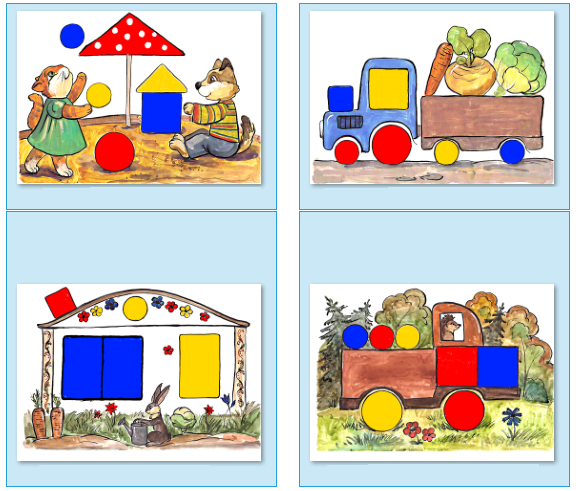
Didactic game "Spaceship"
Material:
Hoops of red, blue, yellow colors, a large triangle rocket from carpet or cardboard, cards with properties symbols or logic cubes, Dienesh blocks.
Purpose:
Formation of the classification surgery and generalization of blocks one-four features, the development of logical thinking, attention.
Game description:
Hoops are laid out on the floor in a row, a triangle rocket is added. Using cards with properties or logic cubes (except color), a condition for each of the hoops is determined.
Rules: To bring the comic ship in orbit, it is necessary to fill the fuel all three stages of the rocket carrier, in accordance with the condition.
Game options:
First option. Children are divided into teams, each of which fills their hoop, the conditions in the hoops are equivalent in difficulty.
Second option. Children choose the hoop on their own, which will fill, and / or condition, throwing the cube, the conditions in the hoops are different in the degree of complexity.
Third option. You can fill out any hoops, conditions in hoops can be both the same and different level of complexity.
Difficulty level:
Simple: The condition specifies only the color of the hoop, or is added another property (shape, size, thickness).
Medium: 2 types of properties characters cards, such as form and size, shapes and thicknesses, etc. are used.
High: All cards with properties symbols including denial are used.
Additional material: Sounds of the jet engine, the riddles of space.
Game "Decorate Christmas Tree Beads"
Material: image of the Christmas tree, 15 cards with symbols, a set of logical shapes
Purpose: Development of the ability to identify and abstruct properties. The ability to "read the scheme". Fastening the skills of the sequence account.
The course of the game: you need to decorate the Christmas tree beads. On the Christmas tree there should be 5 rows of beads. In each row there are three beads. The digit on the card indicates the sequence number of the bead thread (the account is starting from the top of the Christmas tree). Throw the first row of Bus (cards with digit 1). The circle sharpened shows us the place of beads on the thread. The first bead is a little yellow circle, the second large yellow square, the third small
yellow triangle. Similarly displacing other beads.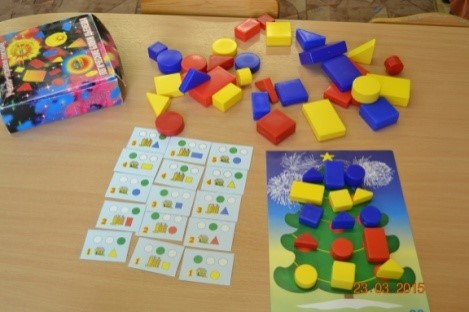
Movable game "Cats-Mouse"
Objective: Develop the ability to "read" cards with properties symbols, identify the necessary properties, stimulate the motor activity of children.
Materials: Tests on ribps with properties for cat and mice.
Game Stroy: Children (4-9 people) Choose tokens for mice and put them on their heads, get up in the dance. In the middle of the cat "Vaska" (it can be chosen using readings V.Live). Next to it tokens for a cat.
The dance is moving with the words:
-I wipe the dance,
On the laying a dreaming cat.
Hush, mice, do not make sure you won't be a cat.
That wake up Vaska-cat
And turn away the dance.
On the last word, the cat quickly puts on one of the tolens and turns to "mice". So that they see it. Tokens - information for mice, what kind of "mice" cat will bring. The remaining mice cat is not terrible, they can have fun, tease Vaska. The caught mouse becomes a "cat" and the game continues.
Note: You can use cards with properties symbols as tokens.
Difficulty levels: Start the game follows from the simplest color properties, then complicate, changing the properties and combining them. For example: Cat catches red and round mice.
High level of complexity - the presence of logical denial.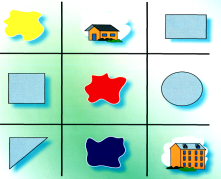
Didactic game "Find me"
Purpose: Development skill read code designation of geometric shapes and find the appropriate code.
Material: Set of blocks, 3 copies of code cards (2 - with normal code, 1 - with denial code).
Games: Children are divided into two groups. One takes cards, the other is blocks. Children of the first group in turn read (decoded) cards, a child from the second group, which turned out to be the corresponding block, it turns out and shows a geometric shape.
It is possible to use words:
"Blocks, blocks of different yellow, blue and red,
We all of them are familiar, find me! "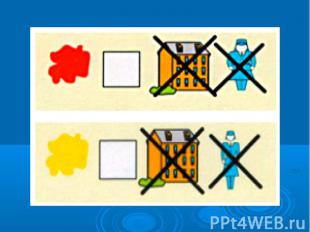
Didactic game "Snail"
Purpose: I exercise children in the classification of blocks on two signs; Color and shape.
Material: Playing field with a spiral image or color tape, block set.
Game Traffic: The educator proposes to build a house for a snail house from magic figures. The house is elegant and beautiful. Laying blocks begins with the middle of the spiral. One block is arbitrarily taken, then a block is attached, in which one characteristic of the previous block will be present.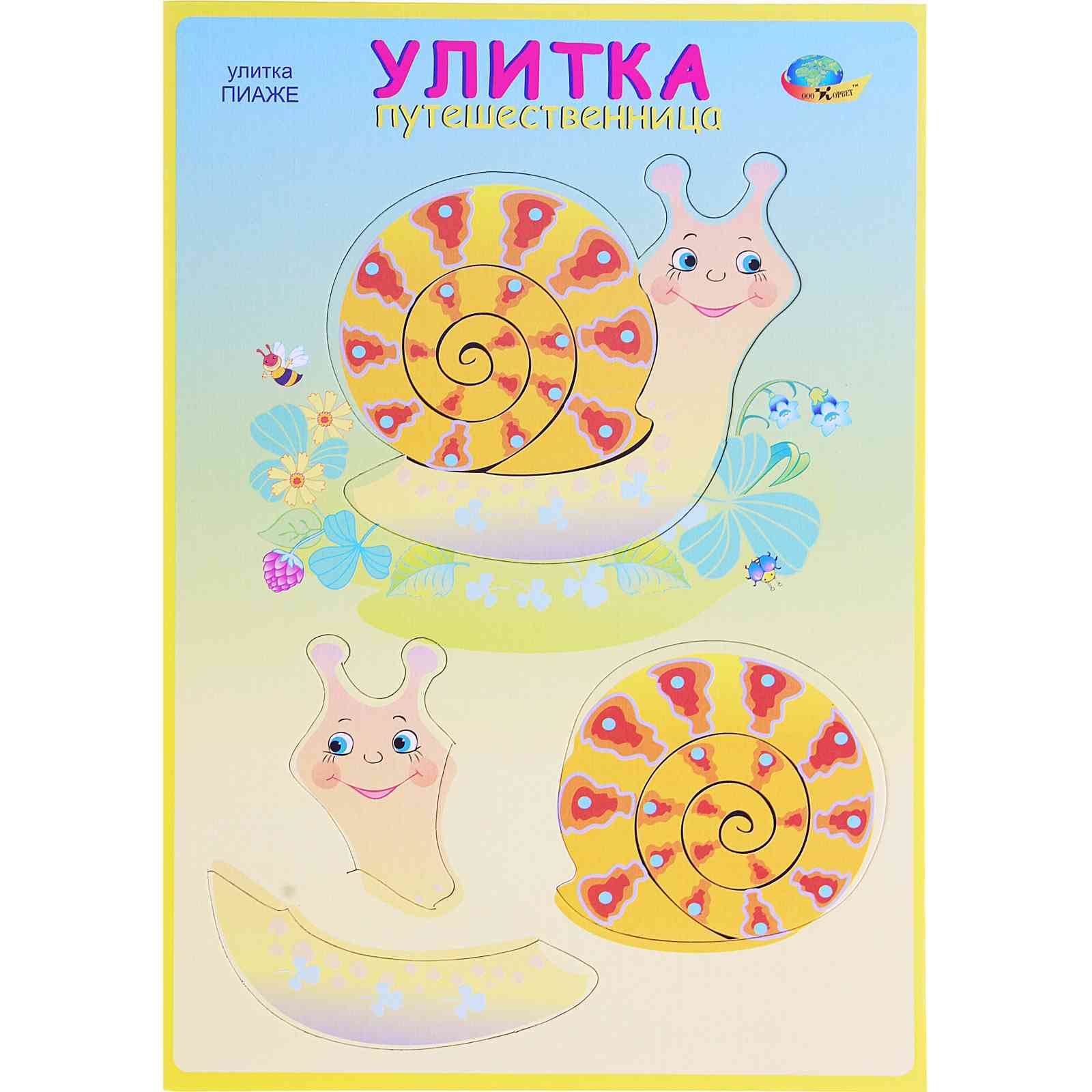
Didactic game "Domino"
Purpose: develop the ability to identify the properties of geometric shapes.
Material: Dienesh blocks.
This game can be played by several participants at the same time (but not more than 4x). Blocks divide equally between players. Everyone makes the turn in turn. If there are no figures, you need to skip the move. Wins the one who will be the first to lay out all the figures.
How to walk?
Figures of another size (colors, shapes).
Figures of the same color, but of other sizes or the same size, but another form.
Figures of a different size and shape (colors and size).
The same figures in color and form, but of other sizes.
We walk the figures of another color, shape, size, thickness.